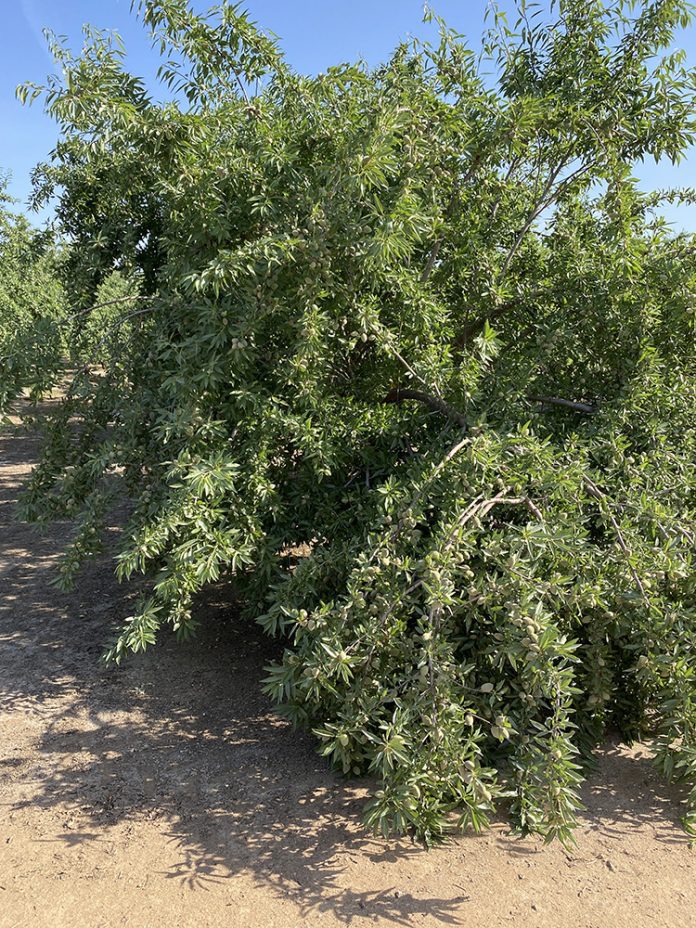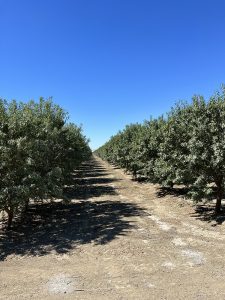
For growers who may have skipped or shorted their trees on nitrogen last year, the question for many is, what are the implications for next year’s trees and what should they do about it. Leaf tissue analysis, considering all sources of nitrogen and an efficient irrigation system are all important considerations when deciding to short or skip in-season and late-season nitrogen applications in almond orchards.
Sebastian Saa, associate director of research for Almond Board of California, said growers who have not applied a final N application this year should also look at yields and how much N was removed at harvest.
“It is important this year to apply N carefully. Growers knowing their yields being less than expected may have an opportunity to skip that final N application.”
Saa said understanding how much N is in the soil and the tree will help with a decision on N applications. Making one fertilizer decision for multiple orchards can also cause lost yield and wasted N. Field variability compromises efficiency.
Avoiding Overfertilization
Almond Board of California notes that for instance, managing an orchard for the highest demand could result in 40% overfertilization. Managing for the lowest demand could deprive 50% of trees of adequate N. Managing to the average could waste 20% of applied N and deprives 30% of trees of adequate N. This is an example of a situation where a grower is not following the 4R principle.
Following the “4 Rs” for efficient nitrogen management remains a good practice, even in high-cost years. The right rate means matching tree demand with supply (all sources of N); the right time is timing N applications when they will be taken up by the tree; the right place is making sure the N fertilizer is placed where it can be taken up; and the right source to maximize utilization. Almond Board of California also notes that 80% of total N in fruit is accumulated by 130 days after full bloom.
Rich Kreps, CCA with Ultra Gro, said many growers felt like they needed to skip or short their N applications this year with prices being so high. If tissue numbers were well above 3% in-season, he said, N could have been skipped or reduced and still have been fine in July tissues.
If fertigation strategies were effective for uptake, he added, and the other nutrients were much more balanced, N levels may have been just fine this year. Growers often have different timelines for their N applications, too, Kreps said. Some like to be done by May 1, others by June 1 or 15. If a grower chooses later, this may have been a good year to experiment with being done by May 1, he said.

Fewer Sticktights
Kreps also said that he expects those who finish with their N applications early will experience fewer sticktights in their trees at harvest. Applications that were typically done in 40- to 50-unit slugs of N may have gone out in 25- to 30-unit slugs this year, and growers found their in-season tissues were still at levels they’ve had in previous years with heavier fertigations.
Every year, harvested almond crops will remove N and potassium from the orchard roughly at the rate of 68 pounds for every 1,000 pounds of kernel yield for N and 80 pounds for every 1,000 pounds of kernel yield for potassium. The UCCE publication Sacramento Valley Orchard Source reports that these nutrients should not be neglected, and they will have to be replaced every year to maintain long term productivity. If these nutrients have been applied in amounts above that which is taken off in harvest, there may be reserves in the soil, especially if irrigation has not leached them below the root zone. Soil and leaf sample analysis can help to determine if N or K may be present in the soil or leaf tissues and available for uptake and use. At the very least, aim for replacement of removed N.
Critical N levels for almond leaves sampled in July are deficient if less than 2%, adequate at 2.2% to 2.5% and excessive if over 2.7% percent.
The most expensive N is the nitrogen that never benefits the tree because it has leached down out of the root zone.
Irrigation water may also turn out to be an inexpensive source of N. Saa recommends testing to determine N levels in your water source.
Aim for Efficiency
“With high prices, you really need efficiency,” Saa said. That means applying N and water where uptake is maximized. He advises checking irrigation systems for leaks, distribution uniformity and any damage sustained to the system by equipment at harvest. If irrigations are planned, he said to make sure the applications are made carefully with no leaching below the root zone.
The condition of the orchard after harvest is another consideration. If the trees are water stressed and defoliation is occurring or leaves are yellowing, uptake of any nutrients will be limited and the chance to make a nutrient application will be missed.
Applying less N fertilizer does not necessarily mean your trees will be deficient and yield a smaller crop the next year as you may be supplying more than needed inadvertently. It is important to account for all sources of N first, Saa said. If you quantify all the sources of N and the total is less than what the tree needs to produce it’s potential, then lower yields will likely occur. Nitrogen is an essential element, not only for production, but to keep the tree working and capturing carbon dioxide to store energy. Trees will grow less, have fewer shoots, fewer spurs and fewer numbers of nuts in the long term, especially if trees experience a significant deficit.
For more information and guidance on how to manage nutrients in almonds orchards, visit almonds.com/almond-industry/orchard-management/soil-quality-and-nutrients/nutrient-management where you can download The Almond Board’s Nitrogen Best Management Practices (BMPs), which summarize years of ABC-funded research in the areas of nitrogen and nutrient management. A direct link to that resource can be found at the Almond Board website, almonds.com in the grower tools section.










